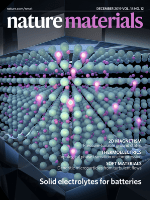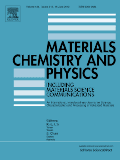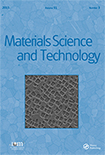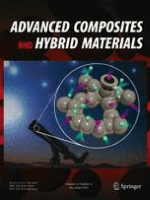
NATURE MATERIALS
Scope & Guideline
Transforming Ideas into Impactful Material Solutions.
Introduction
Aims and Scopes
- Advanced Materials Characterization:
The journal publishes studies that employ cutting-edge techniques for characterizing material properties, including structural, electronic, and optical characteristics, often at the nanoscale. - Innovative Synthesis Techniques:
Research on novel synthesis methods, such as bottom-up and top-down approaches, to create advanced materials with tailored properties is a core focus. - Multifunctional Materials:
The journal highlights materials that exhibit multiple functions, such as energy storage, sensing, and catalysis, showcasing their potential applications in various fields. - Sustainable Materials Development:
There is a strong emphasis on sustainability, with papers addressing the development of eco-friendly materials and processes, as well as recycling and waste reduction. - Interdisciplinary Applications:
NATURE MATERIALS encourages research that integrates materials science with other disciplines, such as biology, chemistry, and physics, to explore new applications and technologies. - Theoretical and Computational Studies:
The journal includes theoretical work that complements experimental findings, utilizing computational methods to predict material behavior and guide experimental design.
Trending and Emerging
- Moiré Materials and Superlattices:
Research on moiré patterns and superlattices is trending, particularly in the context of twisted 2D materials, which offer unique electronic and optical properties that are being explored for next-generation devices. - Artificial Intelligence in Materials Science:
The application of machine learning and AI techniques for materials discovery and characterization is gaining momentum, enabling faster and more efficient identification of new materials. - Bioinspired and Living Materials:
There is a growing interest in materials that mimic biological systems or incorporate living components, which can adapt and respond to environmental changes, opening new avenues for applications in medicine and robotics. - Quantum Materials and Topological Phases:
Research into quantum materials and their topological properties is on the rise, with implications for quantum computing and advanced electronic devices. - Sustainable and Green Materials:
Sustainability remains a key focus, with increasing publications addressing the design and synthesis of materials that minimize environmental impact and enhance recyclability. - Electrochemical Energy Storage:
Innovations in electrochemical energy storage systems, particularly solid-state batteries and new electrode materials, are emerging as critical areas of research due to the demand for more efficient energy solutions.
Declining or Waning
- Traditional Bulk Materials:
There is a noticeable decline in publications focused on traditional bulk materials, as research increasingly shifts towards nanostructured and advanced materials that offer enhanced properties. - Conventional Energy Materials:
Research on conventional energy materials, such as traditional lithium-ion batteries, has decreased as the field moves towards more innovative solutions like solid-state batteries and alternative energy storage systems. - Classic Structural Materials:
Studies centered on classic structural materials, such as steel and concrete, are becoming less prominent as the journal focuses more on innovative composites and smart materials. - Low-Dimensional Materials:
Although still relevant, the volume of research specifically on low-dimensional materials, such as 1D and 2D materials, has waned as interest diversifies into more complex and multifunctional material systems. - Simple Synthesis Methods:
Research emphasizing simple synthesis techniques is declining in favor of more complex, controlled, and innovative approaches that yield higher-performance materials.
Similar Journals

Frontiers in Materials
Connecting Researchers to Shape Tomorrow's Materials.Frontiers in Materials, an esteemed journal published by FRONTIERS MEDIA SA, is a leading platform in the field of Materials Science, with a notable impact factor placing it in the Q2 category of its discipline as of 2023. Since its establishment as an Open Access journal in 2014, it has fostered considerable academic exchange, allowing researchers from around the globe to share their innovative findings and insights. Based in Lausanne, Switzerland, this journal not only emphasizes high-quality peer-reviewed articles but also prioritizes rapid dissemination of research, as evidenced by its commendable Scopus ranking of #62 out of 196 in Materials Science (miscellaneous). By consistently striving to bridge the gap between academia and practical applications, Frontiers in Materials serves as an invaluable resource for researchers, professionals, and students seeking to delve into cutting-edge advancements and transformative applications in materials science.

MATERIALS CHEMISTRY AND PHYSICS
Illuminating the Path of Materials Science AdvancementsMATERIALS CHEMISTRY AND PHYSICS is a leading peer-reviewed journal published by Elsevier Science SA, focusing on the intersection of materials science and condensed matter physics. With an esteemed impact factor and a distinguished reputation in its field, this journal holds a Q1 ranking in Condensed Matter Physics and a Q2 ranking in miscellaneous Materials Science categories as of 2023. Spanning over three decades since its inception in 1983, it provides a vital platform for researchers, professionals, and students to disseminate cutting-edge findings and innovations in materials characterization, properties, and applications. The journal is indexed in Scopus, boasting impressive rankings that reflect its commitment to publishing high-quality research. Although it does not currently offer an Open Access option, it remains an essential resource for those seeking to stay at the forefront of materials chemistry and physics.

Advanced Materials Technologies
Bridging Disciplines in Material ScienceAdvanced Materials Technologies is a leading scholarly journal published by WILEY, dedicated to the rapidly evolving fields of materials science and engineering. With an impressive 2023 impact factor reflected in its Q1 ranking in Industrial and Manufacturing Engineering, Mechanics of Materials, and a notable position within the materials science community, this journal stands as a premier platform for disseminating innovative research and technological advances. The journal encompasses a diverse range of topics, from the fabrication and characterization of advanced materials to their applications in various industries, thus fostering interdisciplinary collaboration among researchers, professionals, and students. Since its inception in 2016 and looking forward to 2024, Advanced Materials Technologies continues to provide unparalleled access to high-quality, peer-reviewed articles, ensuring that it remains a vital resource for anyone involved in the design and optimization of advanced materials.

Materials Futures
Connecting researchers to shape the future of biomaterials.Materials Futures, an esteemed journal published by IOP Publishing Ltd, stands out as a pivotal resource in the field of Materials Science, with a particular emphasis on Biomaterials. Launched in 2022 and operating under an Open Access model, the journal aims to foster accessibility and rapid dissemination of pioneering research, thus catering to the diverse needs of researchers, professionals, and students globally. With a commendable Scopus Rank of #46 out of 137 in its category, placing it in the 66th percentile, and recognized as a Q1 journal as of 2023, Materials Futures provides a vital platform for cutting-edge studies and innovations that address contemporary challenges in materials science. As the journal evolves through its convergence period from 2022 to 2024, it continues to attract high-quality submissions aimed at advancing knowledge and applications within the biomaterials sector, reflecting its commitment to contributing vital insights and fostering collaboration across disciplines. Explore Materials Futures for your research endeavors and join a community dedicated to shaping the future of materials.

MATERIALS SCIENCE AND TECHNOLOGY
Connecting Academia and Industry through Materials InsightsMATERIALS SCIENCE AND TECHNOLOGY is a leading journal published by SAGE PUBLICATIONS INC, focusing on the interdisciplinary advancements in the field of materials science. Since its inception in 1984, the journal has provided a platform for researchers and industry professionals to present innovative findings through rigorous peer-reviewed articles. The journal holds a commendable impact factor and categorizes itself within the prestigious Q2 rank in various domains such as Condensed Matter Physics, Materials Science, Mechanical Engineering, and Mechanics of Materials according to the 2023 Quartiles. With no Open Access option, it primarily serves as a repository for in-depth studies and advancements that push the boundaries of materials engineering and application. Located in the United Kingdom, at 2455 TELLER RD, THOUSAND OAKS, CA 91320, the journal continues to attract a global readership, making it indispensable for academics, researchers, and students who aim to stay at the forefront of materials innovation.

Materials Advances
Catalyzing Collaboration in Materials InnovationMaterials Advances, published by the Royal Society of Chemistry, serves as a premier open-access journal dedicated to the dynamic field of materials science and chemistry. Since its inception in 2020, the journal has quickly gained recognition, achieving an impressive Q1 ranking in both the Chemistry (miscellaneous) and Materials Science (miscellaneous) categories as of 2023. With an impact factor reflective of its high academic standards, it ranks #18 out of 111 in Chemistry and #107 out of 463 in General Materials Science per Scopus metrics. The journal welcomes research articles that explore innovative materials, advanced synthesis techniques, and novel applications, thereby contributing to the ongoing dialogue in materials research. Operating under an open access model, Materials Advances ensures that groundbreaking research is freely available to a global audience, facilitating collaboration and advancements in science. With its headquarters in Cambridge, England, this journal is positioned at the forefront of technological research and discovery, making it a vital resource for researchers, professionals, and students alike.

Advanced Composites and Hybrid Materials
Fostering Collaboration in Advanced Material ResearchAdvanced Composites and Hybrid Materials, published by SPRINGER NATURE, is a premier journal dedicated to the field of materials science, with a keen focus on innovative composite materials and their applications. With its ISSN 2522-0128 and E-ISSN 2522-0136, the journal has established itself as a cornerstone for researchers and professionals in materials chemistry, ceramics, and polymers, achieving an impressive Q1 ranking across multiple categories in 2023. In particular, it ranks #3 out of 161 in Polymers and Plastics and #4 out of 127 in Ceramics and Composites, highlighting its influential presence within the academic community. The journal aims to provide a cutting-edge platform for the dissemination of groundbreaking research and developments from 2018 to 2024, facilitating knowledge sharing and collaboration among experts. While currently adopting a traditional access model, the significance and impact of research published in this journal cannot be overstated, making it an essential resource for anyone interested in advancing the field of composite materials.

Journal of Advanced Dielectrics
Innovating the Future of Dielectrics and CompositesThe Journal of Advanced Dielectrics, published by World Scientific Publishing Co Pte Ltd, is a pivotal open-access platform since 2014 dedicated to advancing research in the fields of dielectrics, ceramics, and composites. Based in Singapore, this journal aims to bridge the gap between theoretical developments and practical applications in Electrical and Electronic Engineering, Condensed Matter Physics, and Electronic, Optical, and Magnetic Materials. With an impressive classification in the 2023 Quartile Rankings indicating its significance within its categories, and notable Scopus Rankings that highlight its impact and relevance, this journal serves as a vital resource for scholars and professionals committed to cutting-edge research and innovation. As it continues to flourish through the converging years from 2015 to 2024, the Journal of Advanced Dielectrics stands as an essential conduit for the dissemination of knowledge in advanced material sciences, making it an indispensable asset for today's research community.

AIP Advances
Empowering Researchers, Enriching Knowledge.AIP Advances, published by AIP Publishing in the United States, is an esteemed open-access journal that has been pivotal in disseminating knowledge in the fields of Nanoscience and Nanotechnology and Physics and Astronomy since its inception in 2011. With an unwavering commitment to enhancing global scientific communication, the journal provides a platform for groundbreaking research and innovative methodologies, catering to a diverse audience of researchers, practitioners, and students. As of 2023, AIP Advances enjoys a respectable impact factor that reflects its significance in the academic community, ranking in the Q3 category for both Nanoscience and Nanotechnology and Physics and Astronomy. The journal has made its contributions accessible, reinforcing its mission of promoting collaboration and knowledge sharing across disciplines. Researchers interested in publishing their work will find AIP Advances not only a valuable medium for their findings but also a hub for the latest advancements and discussions shaping these dynamic fields.

GLASS AND CERAMICS
Pioneering Insights in Ceramics and CompositesGLASS AND CERAMICS is a premier academic journal published by Springer, focusing on the vital fields of ceramics and composites, materials chemistry, and the mechanics of materials. Since its inception in 1956, this journal has contributed significantly to the advancement of knowledge and innovation in these domains, with a commendable 2023 Q3 quartile ranking in its categories. With an ISSN of 0361-7610 and an E-ISSN of 1573-8515, GLASS AND CERAMICS provides a platform for rigorous research and scholarly discussion, catering to a diverse audience of researchers, professionals, and students. Although the journal does not currently offer open access, it continues to disseminate vital insights that drive advancements in the materials science community. The journal’s commitment to high-quality research is underscored by its long-standing publication history and relevance in shaping future materials technology.